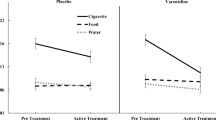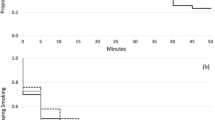Abstract
Craving is thought to play an important role in maintaining regular smoking patterns in current smokers, and in leading to relapse in smokers attempting to quit. Within the scientific community however, the concept is surrounded by controversy. In an effort to 1) identify interventions that can reliably influence cigarette cravings, and 2) assess the relationship between cigarette craving and smoking behavior, effects of aversive rapid smoking (up to nine cigarettes with puffs taken every 6 s) on self-reported craving and subsequent smoking behavior were compared to effects of self-paced smoking or no smoking. Subjects (n = 14) engaged in a rapid, self-paced or no smoking procedure at the start of three separate sessions. Craving levels, measured repeatedly during the next 3 h of no smoking, were significantly lower after rapid smoking than after either self-paced or no smoking. Measures of subsequent smoking behavior (latency to first cigarette, number of cigarettes, number of puffs) did not differ systematically across conditions. Thus, craving was reliably suppressed by aversive rapid smoking, but craving scores did not predict actual smoking behavior.
Similar content being viewed by others
Author information
Authors and Affiliations
Additional information
Received: 2 April 1998/Final version: 7 August 1998
Rights and permissions
About this article
Cite this article
Houtsmuller, E., Stitzer, M. Manipulation of cigarette craving through rapid smoking: efficacy and effects on smoking behavior. Psychopharmacology 142, 149–157 (1999). https://doi.org/10.1007/s002130050874
Issue Date:
DOI: https://doi.org/10.1007/s002130050874




